Search
close
Stay in the loop with our monthly newsletter, bringing you a fresh take on all things property.
Form funnels into a Pardot list to update Prospect sign up for Estate Agent and New Homes
"*" indicates required fields
Annual rental inflation for new lets, UK
Highest in the UK
Highest in a decade
Rental growth in the near term is set to be shaped more by the affordability of renting, and how renters adapt to higher rents, than major shifts in supply and/or demand.
Demand for rented homes is slowing off a very high base but rental supply remains low, keeping an upward pressure on rents. Demand for rented homes is 20% lower than a year ago but still 51% above the 5-year average.
The number of homes for rent is 20% higher than a year ago but remains 30% below average for this time of year. This supply/demand mismatch is an established feature of the rental market across all regions and countries of the UK.
Annual UK rental growth is currently 10.5%, down from 12.1% a year ago as demand moderates and supply slowly improves. Rental growth has been running in double digits for 18 months. Average rents have increased by £110 per month over the last year – an annual increase of £1,320.
Over the last 3 years, rents for new lets are up by an average of £2,772 per year, compounding cost-of-living pressures for renters.
The affordability of renting will have an increasingly important impact on rental growth in the coming months.
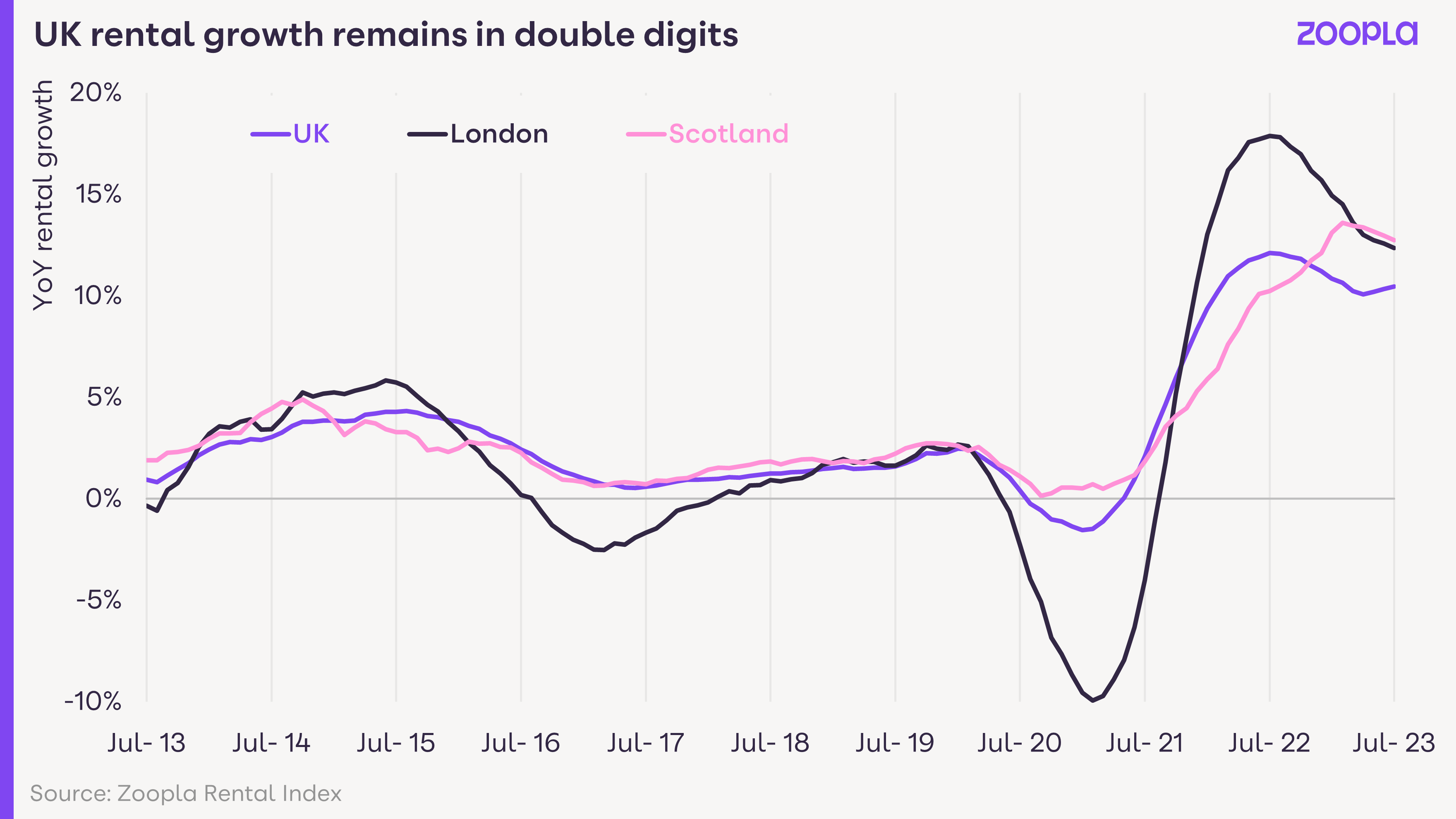
Annual rental growth ranges from 4.2% in Northern Ireland to 12.7% in Scotland, which has overtaken London as the area with the fastest rental growth.
Rents for new lets in Scottish cities are 15.6% higher in Edinburgh and Dundee and up 13.7% in Glasgow.
The introduction of rent controls in September 2022 is a key factor here. These have capped increases in rents for existing tenancies at 3% a year.
As properties become vacant, landlords can reset the rent to the full market rate. This means landlords are seeking to maximise the rent for new tenancies to cover increased costs and allow for the fact that future rent increases will be capped over the life of the tenancy.
This has added extra impetus for rental growth in Scotland versus other parts of the UK.
The rental market remains stuck in a period of low supply and high demand. Growing rental supply is the most efficient and sustainable way to reduce rental growth. However, levels of home building and net new investment by private landlords is falling and set to remain weak into 2024 due to the impact of higher borrowing costs.
New investment from corporate landlords via ‘build-to-rent’ is a bright spot, boosting supply in many city centres. However, rental levels set by corporate landlords are above-average and not at a scale to impact the wider market.
Many existing renters will also try to avoid moving and paying a higher rent, delivering a further drag on available supply. The net result is that the average estate agent has less than 10 homes to rent compared to a pre-pandemic average of 16.5 homes.
Demand for rented homes continues to be driven by multiple factors. The strength of the labour market and job creation is a key driver of rental demand, as is record levels of immigration. This was particularly apparent a year ago as international borders re-opened with an influx of overseas students returning to study in the UK. The number of renters chasing each property for rent spiked to a record high over the summer of 2022.
Demand has risen again this year, tracking the seasonal trend, but is now 20% lower than a year ago. Rental demand is also boosted by higher mortgage rates, which have increased the cost of buying, keeping more would-be buyers in the rented sector.
Mortgage repayments for a first-time buyer are more expensive than rental costs at 5.5% mortgage rates. The greatest impact of this is being seen across southern England.
The net result of these trends is that the current supply/demand imbalance shows no sign of reversing as we move into 2024. Rental growth in the near term is set to be shaped more by the affordability of renting, and how renters adapt to higher rents, than major shifts in supply and/or demand.
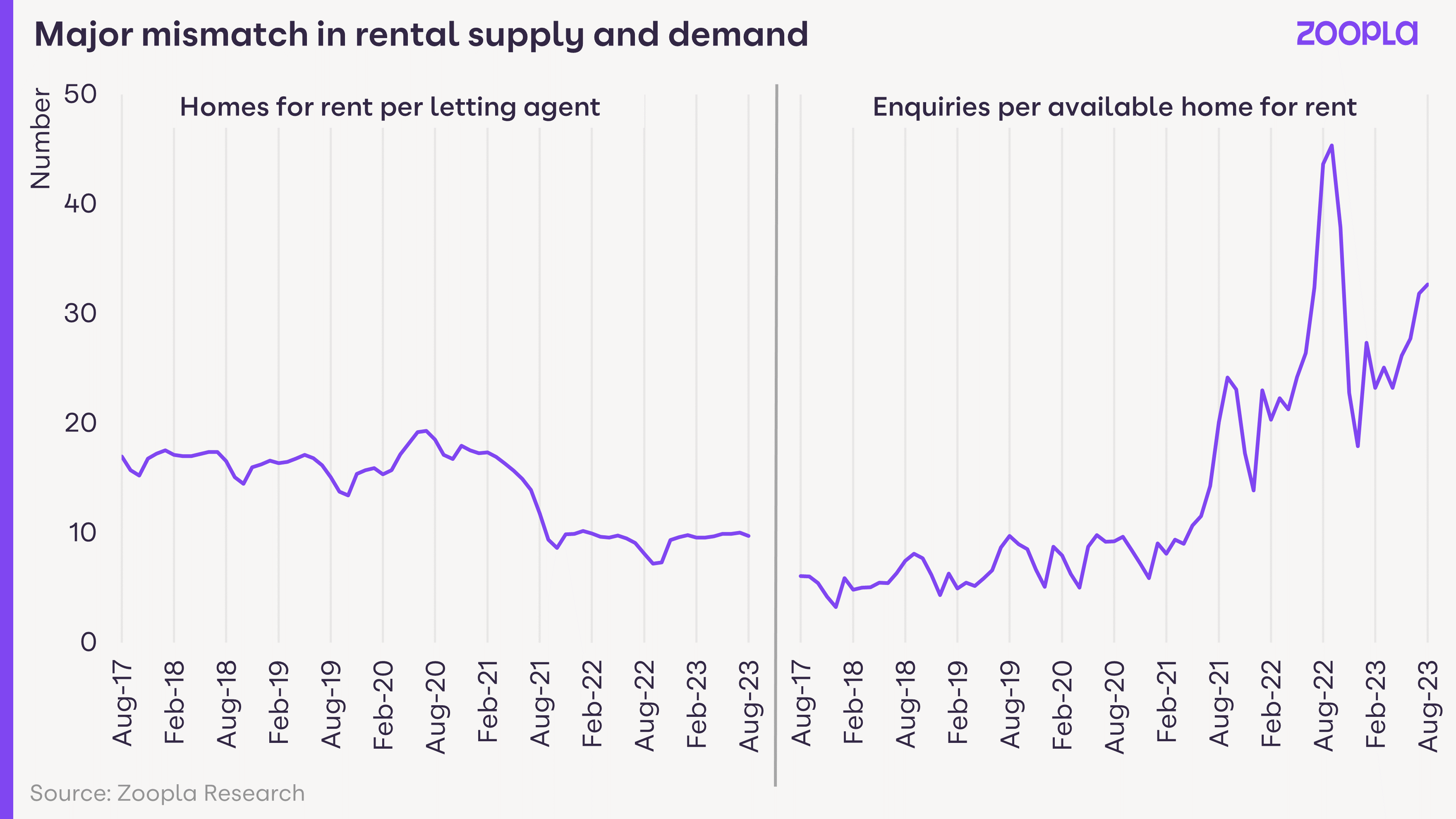
While the pace of UK earnings growth has been accelerating, the growth in rents for new lets continues to be higher, worsening rental affordability.
Over the last decade, the average rent as a percentage of gross earnings has tracked in a narrow range between 25% and 28%, averaging 27.2%. Double digit rental growth means rental affordability is now at its worst for over a decade at 28.4%.
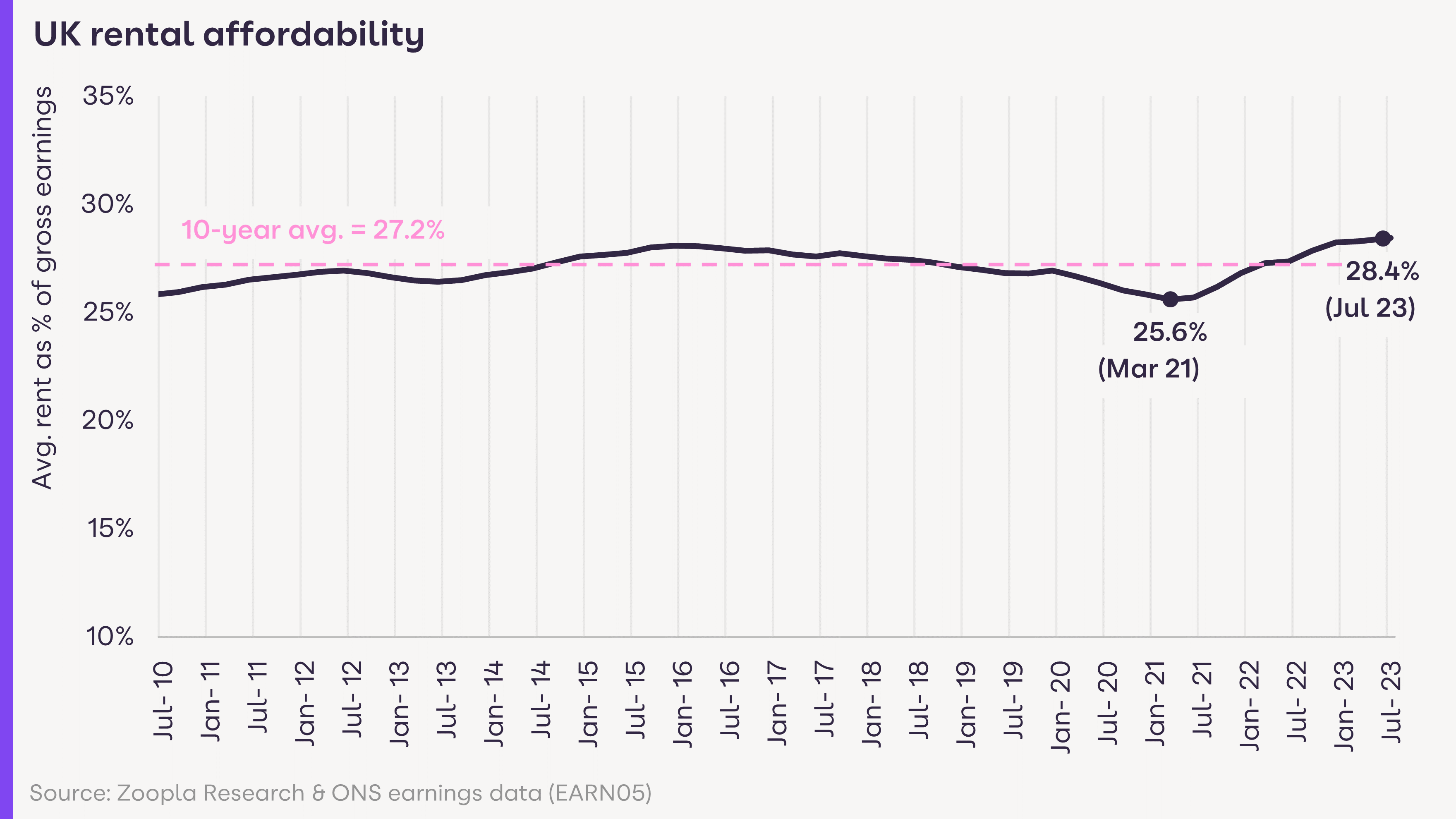
Increasingly unaffordable rental costs should temper demand and lead to a reduction in the rate of growth. However, the scale of the mis-match between supply and demand means that rental growth will reduce more slowly than might be expected.
If supply remains low then a weaker labour market, lower immigration and falling mortgage rates would all be needed to reduce demand to a level that would reduce rental growth back towards 5% per annum.
Faced with higher rents and a scarcity of supply, renters are being forced to consider renting smaller homes, moving to cheaper areas or sharing property with other renters to reduce costs.
More renters sharing does reduce the cost per renter, but this comes at the personal expense of less private space. It also supports headline rental values.
Data from the Resolution Foundation found private renters have experienced a 16% reduction in floorspace per person over the last 20 years. In our view, sharing is supporting high rents in inner London, where the reduction in floorspace per renter has been greatest. Increased levels of sharing could be a key factor in rents continuing to rise above earnings across regional cities over the next 12-24 months.
Rental growth at a city level is running from 6% per annum in Brighton and Exeter, up to 15.6% in Edinburgh and 14% in Manchester. Several cities are registering slower annual growth than a year ago, while others are tracking at a similar rate of growth. The biggest slowdown has been registered in inner London. In this area, rents are slowing from a high base, having sharply rebounded following the pandemic.
There is a clear trend emerging in London with the impetus for rental growth coming from the outer London suburbs as renters seek better value for money. We expect rental growth in inner London to slow further in H2. This is due to expanding supply on the back of new build sales to corporate investors and affordability pressures impacting demand.
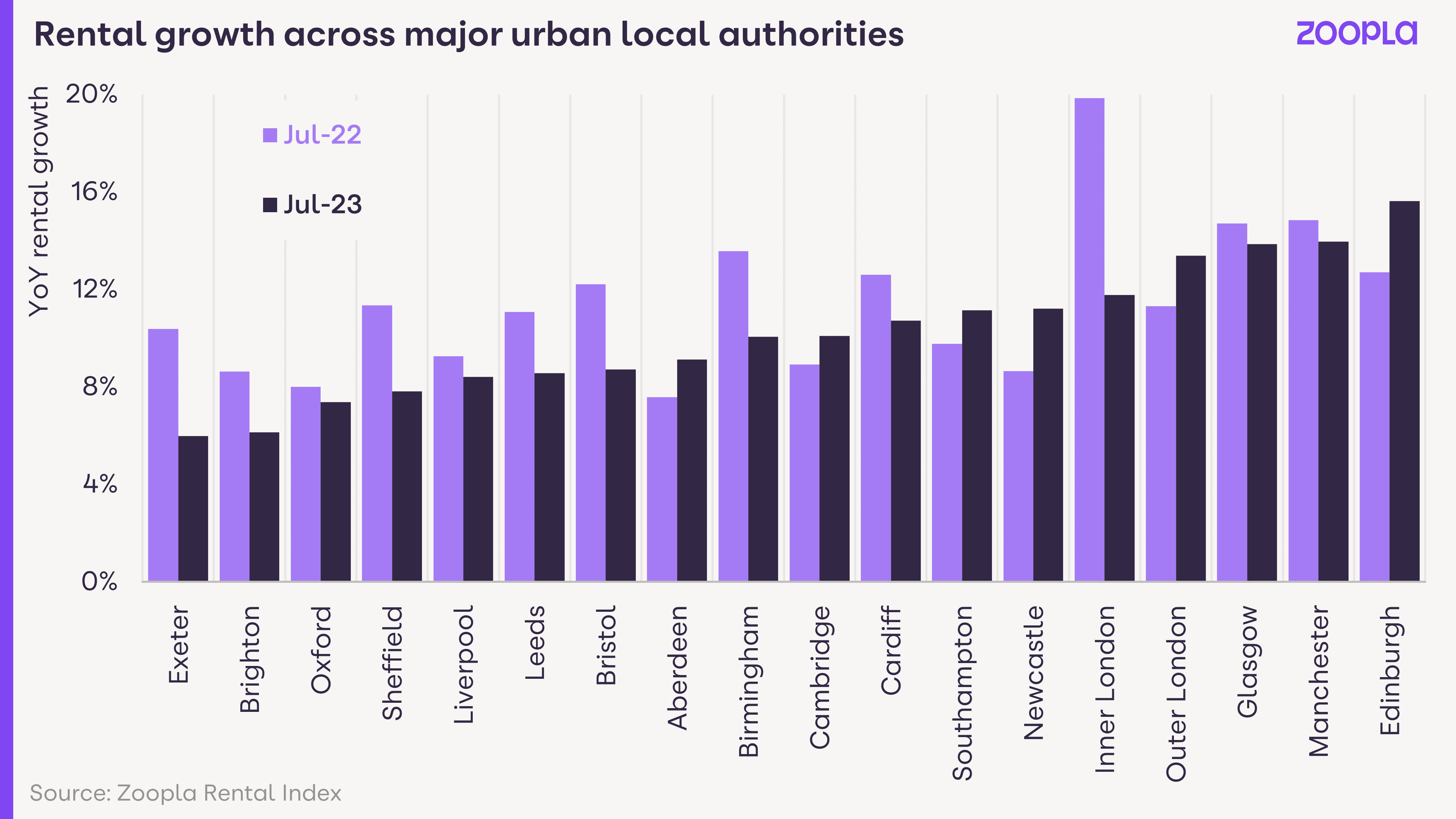
Rental growth is on track to end the year at over 9%, higher than earnings growth, which is expected to be 6%3. Rental growth is higher than we anticipated due to faster earnings growth and the impact of higher mortgage rates keeping more people renting.
Rents for new lettings are expected to keep rising ahead of earnings growth in 2024, projected to be 3.6%3 , in the face of ongoing supply constraints and sustained higher mortgage rates.
We currently anticipate UK rental growth of 5-6% in 2024 with the impetus for growth originating from regional cities.
We believe rental inflation in inner London will slow more quickly in the next year in the face of higher rents and affordability constraints.
This would act as a drag on the UK rate of growth, potentially halving it to more sustainable levels.
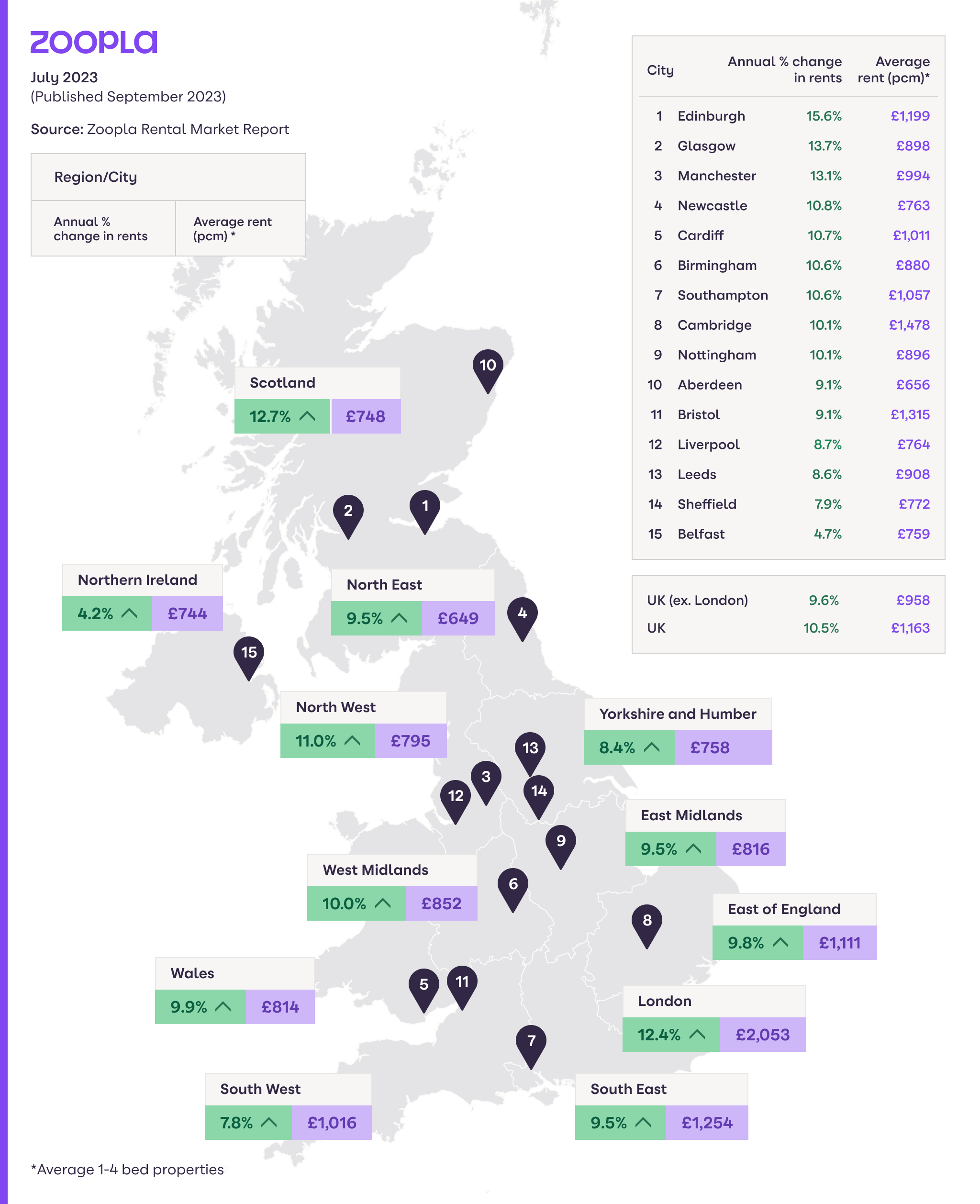

UK house prices increase 1.6% as tariffs, stamp duty changes and broader economic uncertainty dampen buyer demand

House price inflation slows to 1.8% as the supply of homes for sale outpaces the growth in sales agreed

The housing market gets off to its strongest start in three years, with new sales agreed up 12 per cent on 2024.